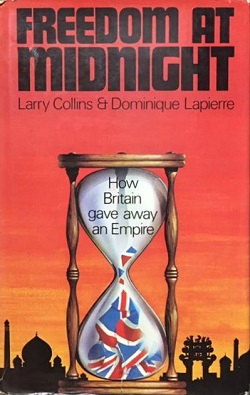Freedom at Midnight
Freedom At Midnight .pdf Ebook Download
pdf-search-engine.com/freedom-at-midnight-pdf.html - Cached
From Wikipedia, the free encyclopedia
Freedom at Midnight (1975) is a book by Dominique Lapierre and Larry Collins. It describes the events in the Indian independence movement in 1947-48, beginning with the appointment of Lord Mountbatten of Burma as the last viceroy of British India, and ending with the death and funeral of Mahatma Gandhi.
The authors having interviewed many of those who were there, including Lord Mountbatten of Burma, the book gives a detailed account of the last year of British India, the princely states' reactions to independence (including descriptions of the Indian princes' colorful and extravagant lifestyles), the partition of India and Pakistan on religious grounds, and the bloodshed that followed. It also covers in detail the events leading to the assassination of Mahatma Gandhi, as well as the life and motives of British-educated Jawaharlal Nehru and Pakistani leader Muhammad Ali Jinnah, a secular Muslim. The book is a result of deeply scanned and researched events, which often are left out by other historians. For example, the crucial maps separating India and Pakistan on religious grounds, were drawn that year by a man named Cyril Radcliffe who had never visited India in his life before being appointed as the chairman of the Boundary Commission. The description of the very British-style summertime capital Shimla in the Himalayas and how supplies were carried up steep mountains by porters each year is interesting. The book also explains the fury of both Hindus and Muslims, misled by their communal leaders, during the partition, and the biggest mass slaughter in the history of India as millions of unfortunate people were uprooted by the partition and tried to migrate laboriously by train, oxcart, and on foot to new places designated for their particular religious group. Many migrants fell victim to bandits and bloodthirsty religious extremists of both dominant religions. One incident quoted is particularly terrifying: it describes a canal in Lahore that ran with blood and floating bodies. A tragedy that befell a poor but sincere interfaith peasant couple is heart-rending.
Controversial for its portrayal of the British expatriates, the native rulers of India and members of India's first cabinet, it is a non-fiction book told in a casual style, similar to the authors' previous Is Paris Burning? and O Jerusalem!.
Collins and Lapierre also wrote a book about their researches with respect to Mountbatten, titled Mountbatten and the Partition of India by vinod RB. This book contains interviews with Mountbatten, and a selection of papers that were in his possession. The book mainly is a detailed portrayal of the various events, good and bad happening in India. The book, unlike others, reveals many stunning facts which would perhaps be never unearthed without an extensive research as the author. The most engrossing aspects of the book are the heart-rending portrayals of the religious carnage which occurred after the Partition. Another thing which makes it interesting is the highlight on the lives and the roles of the various insignificant monarchies scattered across British India. In all, this book is a complete documentation of the Indian political imbroglio at the time of Partition, and the helpless struggle of Mahatma Gandhi to save his country from Partition and from the clutches of his political foe, Mohammed Ali Jinnah, and Gandhi's final moments, which have been documented with frightful detail.
[edit] External links
Freedom At Midnight .pdf Ebook Download
- [ Translate this page ]E-book pdf search engine. Enter book title. freedom at midnight ... Freedom-at-midnight.pdf - Search freedom midnight.pdf torrents search ...
www.pdf-search-engine.com/freedom-at-midnight-pdf.html - Cached - SimilarFreedom At Midnight By Dominique Lapierre .pdf Ebook Download
E-book pdf search engine. Enter book title. Looking for : freedom at midnight by dominique lapierre ... 1947freedmmidnt.pdf - Search freedom midnight ...
www.pdf-search-engine.com/freedom-at-midnight-by-dominique-lapierre-pdf.html - Cached - Similarfreedom at midnight eBook Downloads
freedom at midnight free PDF ebook downloads. eBooks for Business, Education,Finance, Inspirational, Novel, Religion, Social, Sports, Science, Technology, ...
www.pdfgeni.com/htm/.../freedom-at-midnight-pdf.html - Cached - SimilarFreedom at midnight eBook Downloads
Freedom at midnight free PDF ebook downloads. eBooks for Business, Education,Finance, Inspirational, Novel, Religion, Social, Sports, Science, Technology, ...
www.pdfgeni.com/book/Freedom-at-midnight-pdf.html - CachedFreedom at Midnight by Dominique Lapierre; Larry Collins ...
Freedom at Midnight, a book by Dominique Lapierre; Larry Collins.
www.ebooknetworking.com/books_detail-8125904808.html - Cached - SimilarWho is the writer of freedom at midnight? - Ask or Answer Books ...
Who is the writer of freedom at midnight?, Ask your Books & Authors ... Basically, ebook is an online book. ebook is the book which you can read only on ...
sawaal.ibibo.com › Recreation › Books & Authors - Cachedfreedom at midnight.pdf torrents search
freedom-at-midnight.pdf torrent search results. Bittorrent downloads listed here. ... Uncle.Sam.And.Freedom.Fighters.Vol.2.No.6.Apr.2008.Comic.eBook-. ...
www.torrentreactor.net/find/freedom-at-midnight.pdf - Cached - SimilarFreedom at midnight e book - .Pdf & Word Free Ebooks Download
Download freedom at midnight e book for free. Download your favorite freedom at midnight e book at Pdfdatabase.com.
pdfdatabase.com/index.php?q=freedom+at+midnight+e+book - CachedFreedom at midnight book - .Pdf & Word Free Ebooks Download
Download freedom at midnight book for free. Download your favorite freedom at midnight book at Pdfdatabase.com.
pdfdatabase.com/index.php?q=freedom+at+midnight+book - CachedFree freedom at midnight free ebook Download - freedom at midnight ...
Free download freedom at midnight free ebook ebook at ebook30.com ebook download playboy magazine, penthouse. Links from rapidshare megaupload torrent sites ...
ebook30.com/free/freedom+at+midnight+free+ebook/ - 11 hours ago
| freedom at midnight ebook | ||
| freedom at midnight larry collins | david benoit freedom at midnight | freedom midnight book |



No comments:
Post a Comment